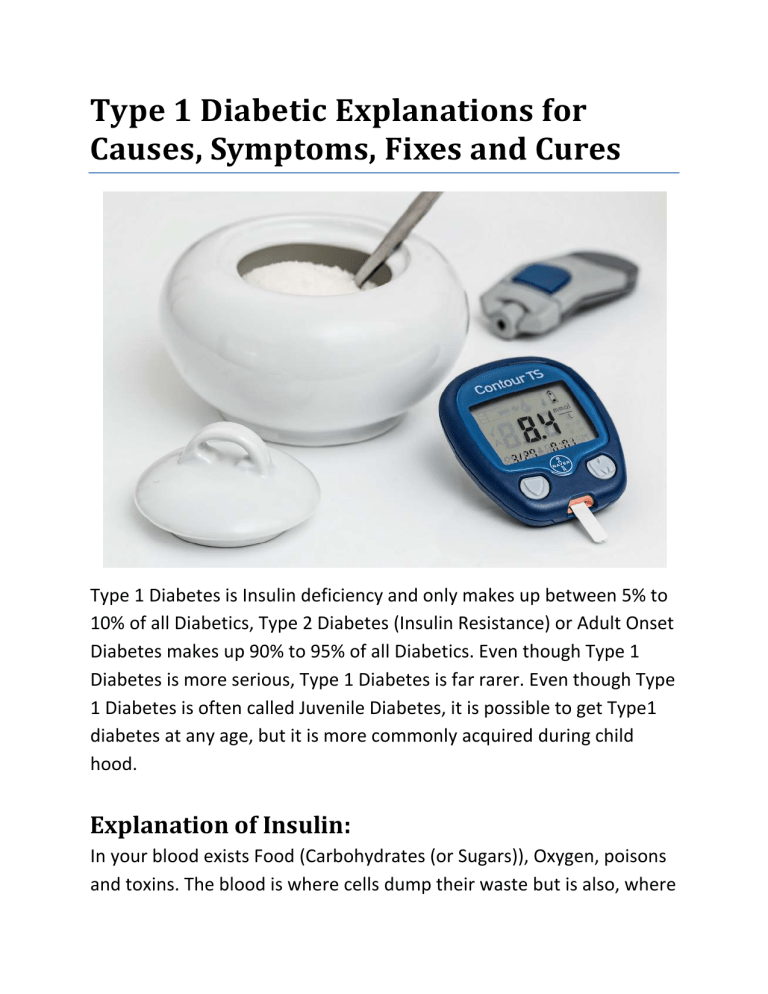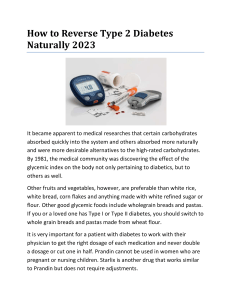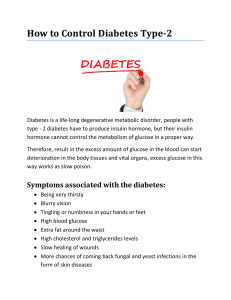
Type 1 Diabetic Explanations for
Causes, Symptoms, Fixes and Cures
Type 1 Diabetes is Insulin deficiency and only makes up between 5% to
10% of all Diabetics, Type 2 Diabetes (Insulin Resistance) or Adult Onset
Diabetes makes up 90% to 95% of all Diabetics. Even though Type 1
Diabetes is more serious, Type 1 Diabetes is far rarer. Even though Type
1 Diabetes is often called Juvenile Diabetes, it is possible to get Type1
diabetes at any age, but it is more commonly acquired during child
hood.
Explanation of Insulin:
In your blood exists Food (Carbohydrates (or Sugars)), Oxygen, poisons
and toxins. The blood is where cells dump their waste but is also, where
they get their food and oxygen. To prevent your cells from eating
wrong thing and dying, your body has a system setup whereby your
cells only must look for one Digestive Hormone: Insulin. Thus, reducing
the already many complicated things each of your cells must do, leaving
the cell only to rely on Insulin to find the cells food (sugar).
All Insulin is doing, is communicating a Hormonal message between a
sugar Molecule (Carbohydrate) and a cell, thus permitting the cells to
find the sugars in the blood and eat it. Sugars come in many different
forms, many with different kinds of vitamins, nutrients, and others with
no vitamins and nutrients. Therefore, insulin is there to eliminate the
complicated confusion that the cells would otherwise have to deal with,
in addition to performing their other important functions for your body.
In addition, not every cell gets every sugar molecule either; insulin
makes sure those sugars with certain vitamins and nutrients get to the
correct cells. Not every cell gets every sugar vitamin and Nutrient.
Vitamins are quite often dedicated to certain cells.
The insulin itself is not lowering your blood sugar, it is the cells eating
the sugar that lowers your blood sugar levels, but your cells cannot find
the sugar without the help of insulin.
Once the cell gets the hormonal message to eat the sugar attached to
the outer surface of the cell, the cell then takes that sugar molecule to
the cells Mitochondria and bonds it with oxygen with the help of
another enzyme to produce energy, and make the Mitochondria
chemically vibrate. The chemical vibration of the Mitochondria is what
keeps the cell alive. If that sugar molecule contained a vitamin or
nutrient of some sort, then that vitamin or nutrient converts that
energy into literal functional work inside that cell, through a complex
set of chemical chain reactions triggered by that burst of energy.
Sugars from Fruits and vegetables always contain some sort of vitamin
or nutrient. Refined sugar does not. Eating refined sugars is like running
your car on gasoline with no transmission fluid, whereby your heater
might work, but your car is not going anywhere and not going to do
much of anything important. Making it a colossal waste of insulin,
enzymes and oxygen to get that energy produced.
Explanation of Glucagon:
Not only is the production of Insulin damaged or destroyed in Type 1
Diabetes, but also the Hormone Glucagon is damaged or destroyed as
well. Glucagon is another important Digestive Hormone that is
produced by your pancreases when the pancreases detect a low sugar
event. This hormone sends a message to your Liver to make more sugar
from the fat stores in your body. If this hormone is not produced, then
your liver never gets the message and your blood sugars can drop to
dangerously low levels. In addition, if your sugar levels get too low, you
are just as dead as if your oxygen levels dropped too low as well.
Remember, without sugar you cannot metabolize oxygen. In addition,
people that cannot metabolize oxygen are called dead people. In
addition, for that reason, Type 1 Diabetics are sometimes also supplied
with emergency injections of Glucagon, if eating a sugar tablet, candy
or fruit cannot be consumed or acquired when experiencing a low
blood sugar attack. Which can happen, when the brain gets deprived of
Sugar, it malfunctions first, leaving the victim unable to eat or drink
anything?
Causes of Type 1 Diabetes:
The common popular myth is that eating too much sugar causes
Diabetes. This is a very misguided belief; your body needs sugars to
metabolize Oxygen. Matter of fact, the only reason you are breathing
oxygen to stay alive right now is because of sugar. If you did not need
sugar for energy, you would not need to breathe oxygen to stay alive.
Not being able to metabolize sugars is a symptom of this disease, not
its root cause. Sugar no more causes Diabetes than oxygen causes Lung
Cancer.
IMMUNE RESPONSE DISORDER is the primary cause for Type 1
Diabetes. Most Type 1 Diabetics come down with this disease about 2
weeks after recovering from a major illness, usually the measles, the
flu, food poisoning, etc. whereby in defense of your body; your immune
system accidentally makes an antibody to destroy the invading virus or
bacteria with antigen attacking anti-body's that also attack and kill islet
cells in your pancreas, just because they happen to have a common
antigen code that matches the anti-body produced by your immune
system. Thus, Type 1 diabetes can be caused by a defective immune
system that kills the insulin producing islet cells in your pancreases. But
quite often also kills the islet cells that also produce the Digestive
Hormone Glucagon as well.
TYPE 2 DIABETES (Insulin Resistance) at first can cause your pancreas to
produce 32 times more insulin than in a none diabetic as the insulin
resistance gets worse. In addition, if gone poorly managed for a long
time can eventually take a toll on your pancreases ability to produce
insulin and force you to become both a Type 1 and 2 Diabetic.
However, Type 2 Diabetes has a different cause, a malfunctioning
duodenum causes it, and by fixing the duodenum, you can cure Type 2
Diabetes and 80% of the time Type 1 diabetes if Type 2 caused it.
However, if any of the other causes of Type 1 mentioned here got
involved, then the Type 1 may not go away, even if the Type 2 did go
away.
PANCREATITIS can also cause Type 1 Diabetes by destroying your
pancreases' islet cells that produce insulin and glucagon. Your pancreas
also produces digestive enzymes that are normally in an inert none
reactive state while still in the pancreas, and normally don't get
activated until after they pass through the pancreatic duct and then
into your duodenum. However, in pancreatitis these digestive enzymes
mysteriously become prematurely activated while still in your pancreas.
Which causes your pancreas to be digested by your own digestive
enzymes; these digestive enzymes get into your blood stream as your
damaged pancreas bleeds and starts to digest your body next. Doctors
can detect pancreatitis by doing a blood test, and finding these
digestive enzymes, if this can be caught fast enough you might be
spared Type 1 Diabetes or even save your pancreas for total flat out
destruction. Pancreatitis has all the same symptoms of the flu.
PANCREATIC CANCER can also cause Type 1 Diabetes, as you lose your
pancreas to cancer you will become Type 1 Diabetic, but you will also
begin to lose the ability to digest your food, and then start to lose
massive amounts of weight. Life expectancy is not very good either, as
the medications that help you digest your food is not perfect and has
flaws with side effects. In addition, in pancreatic cancer can also spread
throughout your body as this disease progresses.
Symptoms:
Type 1 diabetes can hit you very quickly and, in many cases,, you may
only have a week or 2 to figure out what is going wrong before you are
in real trouble.
MASSIVE WEIGHT LOSS not weight gain, is one of the Symptoms of
Type 1 Diabetes. This is caused by keto acidosis that is caused by your
liver freaking out. Your liver and nervous system have a very close
symbiotic relationship, and in Type 1 diabetes, your body is full of food,
but your cells are starving to death because there is not any insulin to
help them find their food in the blood. Your nervous system alerts your
liver that your nerve cells are starving to death, the liver then freaks out
and releases ketone to drain all the fat in your fat cells to be converted
by the liver into sugar. However, the liver does not realize it is not a
sugar level problem, but an insulin problem. Therefore, your blood
sugars continue to skyrocket while your fats are drained from your fat
cells.
HIGH BLOOD SUGAR LEVELS will cause the blood viscosity to increase.
Normally your blood is 70% water, so your blood should have the same
thickness viscosity as water at normal blood sugar levels 80 to 120
mg/dl. However, if it gets as high as 180mg/dl the viscosity is as high as
Wesson Oil. Moreover, as the sugar levels get higher, so does your
blood viscosity. This higher viscosity blood has a harder and harder time
passing through the small capillaries in your body. This traffic jam in the
capillaries causes the blood to back up and sky rocket your blood
pressure, making the problem even worse. This puts a strain on
capillaries in your eyes that can cause eye damage or blindness,
damage to your kidneys, liver and heart as well. The capillaries in your
feet are even worse, as your body presses down hard on the capillaries
there; the blood has an even harder time passing through those
smashed capillaries. Therefore, diabetics are always having feet
problems and, in many cases, losing their feet to gangrene or walking as
if their feet are very tender. High blood sugar levels also will mean that
your cells are not eating the sugar and are starving while gradually
losing the ability to metabolize oxygen. This will manifest itself as
making you very sleepy and tired, especially after eating a meal. You
have a body full of food, but your cells are starving. The final stage of
digestion is when your cells eat, and if your cells are not eating, you
have not really eaten either. However, the solution is not to eat more
food, but instead fix the insulin production problem.
SLEEP AND TIRED all the time
FREQUENT URINATION about every half hour or so. Because your
kidneys have detected the threat of high, blood sugars and are trying to
bring blood sugars back to normal healthy levels by expelling the
sugars. This in turn damages the kidneys as this is not the normal
function of the kidneys to dispose of food, the purpose of the kidneys is
to dispose of toxins and poisons.
FIXES:
An INSULINE injection is the fix but trying to determine the right level
of insulin is about as tricky as trying to shoot the rapids in a sailboat.
Prior to 1927, there was no insulin, and most people that got Type 1
Diabetes were going to die within a few short weeks. However, it is not,
it is only a fix. Insulin can only be injected because it is a digestive
hormone, and digestive hormones are specialized protein-poly-
peptides that communicate messages between a sugar molecule and a
cell. So, if you try to eat insulin it would become destroyed in your
digestive track and never make it into your blood stream as true insulin,
only broken up protein molecules or as amino acids.
INSULINE PUMP is a better fix. When your pancreas is working
correctly, the amount of insulin is very accurately regulated. When you
manually try to determine your insulin levels you either end up with too
little causing blood sugars that are not low enough or too much causing
a life threatening low blood sugar level. However, as Insulin pumps
become better they come with a blood sugar sensor and a built in
regulated insulin pump that more accurately injects the correct amount
of insulin periodically, just like your once working pancreas used to do.
There is still some human controls required, but as time passes these
Insulin pumps become more and more autonomous and more accurate.
However, be aware that these pumps can be quite expensive, but as
time passes, they will become more and more affordable as the
technology advances.
TYPE 1 DIABETIC CURES:
ISLET TRANSPLANTATION is only done on Type 1 Diabetics that are on
their deathbed dying of Type 1 diabetes, which is rarely the case. Most
Type 1 Diabetics do a successful job of insulin management, diet and
exercise, and are therefore not a candidate for Islet Transplantation.
Islet Transplantation can take 2 different forms: (1) either transplant
the pancreas from a none diabetic donor into the Diabetic's pancreas,
or (2) inject islet cells into your liver. If the Diabetic is prone to
pancreatitis, then injection of islet cells into their liver is preferred.
Once injected the Islet cells start to produce regulated insulin into your
blood automatically.
The Bad news is, since this is an organ transplant of a foreign organ, you
will probably be on immune depressants for the rest of your life. Thus,
you must be willing to trade your Type 1 Diabetes in for medically
induced AIDS. The immune depressants are very expensive and must be
taken for the rest of your life.
This procedure is still considered an experimental treatment for
Desperate Type 1 Diabetics and there are only 43 clinical institutions
around the world that perform this procedure. In addition, to date, only
471 people with Type 1 Diabetes have received islet transplants.
So, as you can see this cure is not a very pretty one, lots of ugly side
effects and expensive medications for the rest of your life. So only, the
most desperate and wealthy Type 1 Diabetics can qualify.
Get great advice and guidance from Daily Health Guide on how to lose
weight, deal with your Diabetes and other serious Health issues
affecting your life or the lives of others, and please check us out!









